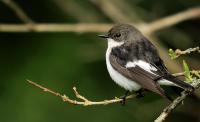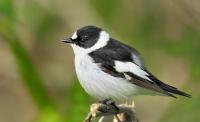
The European pied flycatcher, and later its close relative the collared flycatcher, have long been an important research organism for scientists at many universities. Just how new species are established is still one of the most central questions in biology. In an article in the leading scientific journal Nature, researchers at Uppsala University in Sweden describe how they mapped the genomes of the European pied flycatcher and the collared flycatcher and found that it is disparate chromosome structures rather than separate adaptations in individual genes that underlies the separation of the species.
"We were surprised that such a large part of the genome was nearly identical in the two species," says Hans Ellegren, professor of evolutionary biology and director of the research team behind the new findings.
The big question in species-differentiation research today involves the genetic background of how two evolutionary lines gradually come to diverge from each other and ultimately cannot produce fertile young. Horses and donkeys, for instance, can crossbreed and produce mules and hinnies, but something in the genome of the latter makes them infertile. There must therefore be DNA sequences from diverging evolutionary lines that are not compatible. 
The European pied flycatcher, and later its close relative the collared flycatcher, have long been an important research organism for scientists at many universities.
Researchers at the Evolutionary Biology Centre, Uppsala University, are now presenting the genome sequence for the two flycatchers, which are the first organisms apart from so-called model organisms, to have their genome sequenced. They are also the first DNA sequences for a vertebrate to have been determined entirely by Swedish researchers and at a Swedish laboratory.
The Uppsala scientists have charted the genome of the flycatchers and then sequenced the entire genome of some ten individuals of European pied flycatcher and the collared flycatcher respectively. The two species occur together on the Baltic islands of Öland and Gotland, where they sometimes hybridize, that is, mate with each other.
The scientists have now managed to identify the regions in the respective flycatchers' genomes that are most clearly different. It turns out that it is a matter of one or a few regions per chromosome, and these regions coincide with the chromosome parts that are involved in meiosis and the production of gender cells (centromeres). This indicates that what underlies the separation of the species it is the disparate chromosome structures rather than different adaptations in individual genes.
"There is good reason to believe that this observation is highly generalizable and that it explains species differentiation across organism groups," says Hans Ellegren.
The European pied flycatcher, and later its close relative the collared flycatcher, have long been an important research organism for scientists at many universities. Their nesting (and thereby reproductive success) is rather easy to observe, as they readily inhabit deployed birdhouses. Over the years Uppsala research has laid a foundation for understanding many general aspects of ecology and evolution, with multiple doctoral dissertations and acclaimed research reports. Source : Uppsala University
 Print Article
Print Article Mail to a Friend
Mail to a Friend
